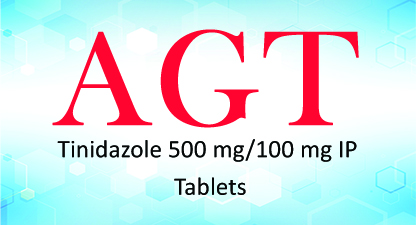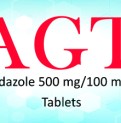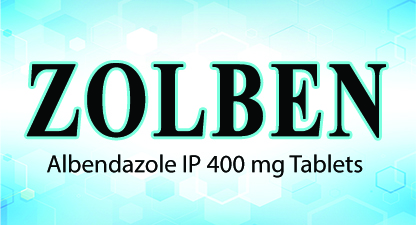AGT
Tinidazole is an anti-parasitic drug used against protozoan infections. It is widely known throughout Europe and the developing world as a treatment for a variety of amoebic and parasitic infections.
- Categories : Anti-Helmintic
- Share Now :
AGT
Generic Name: Tinidazole
Therapeutic Category: Anti-protozoal
Composition: AGT 500
Each film-coated tablet contains Tinidazole IP 500 mg
AGT 1000
Each film-coated tablet contains Tinidazole IP 1000 mg
Pregnancy Category: C
Presentation: Available in the pack size as 10 tablets X 10 blisters
Mechanism of Action
Tinidazole is a prodrug and antiprotozoal agent. The nitro group of Tinidazole is reduced in Trichomonas by a ferredoxin-mediated electron transport system. The free nitro radical generated as a result of this reduction is believed to be responsible for the antiprotozoal activity.
It is suggested that the toxic free radicals covalently bind to DNA, causing DNA damage and leading to cell death. The mechanism by which tinidazole exhibits activity against Giardia and Entamoeba species is not known, though it is probably similar.
- Amebiasis*
- Bacterial Vaginosis (BV)
- Giardiasis*
- Non-gonococcal urethritis*
- Sexually Transmitted Disease (STD)
- Trichomoniasis*
Dosage
Route of administration: Oral
For Amebiasis
Adults: 2 grams per day for three days.
Children 3 years of age and older: 50 milligrams per kilogram of body weight per day (up to to 2 grams per day) for three days.
For bacterial vaginosis (non-pregnant):
Adults: 2 grams per day for two days or 1 gram per day for five days.
For giardiasis:
Adults: 2 grams given once as a single dose.
Children 3 years of age and older: 50 milligrams per kilogram of body weight (up to to 2 grams) given once as a single dose.
For trichomoniasis:
Adults: 2 grams given once as a single dose.
No safety & efficacy data on pediatric patients below 3 years of age.
Pharmacokinetics
P
Protein binding: Approximately 12 %
Metabolism: Hepatic
Route of elimination: Urine (20–25%), feces (12%)
Half-life: 12-14 hours
Adverse Effects
- vaginal itching or discharge;
- nausea, vomiting, loss of appetite, indigestion;
- constipation, diarrhea, stomach cramps;
- feeling weak or tired;
- Headache, dizziness; or.
- a metallic or bitter taste in your mouth;
Contraindications
AGT is contraindicated in:
- Hypersensitivity to Tinidazole or any components of the formulation.
- 1st trimester of pregnancy
- Concurrent lactation (interrupt for 3 days)
- Intake of alcohol: Causes disulfiram like reactions
Precautions
- Caution in patients with history of blood dyscrasias or history of hepatic impairment.
- Risk of convulsive seizures & peripheral neuropathy - caution in neurologically compromised patients.
- Risk of bacterial overgrowth with prolonged treatment.
- Not studied for bacterial vaginosis in pregnant women.
Terminologies*
Amebiasis: An intestinal illness that's typically transmitted when someone eats or drinks something that's contaminated with a microscopic parasite called Entamoeba histolytica.
Giardiasis: An infection in small intestine caused by a microscopic parasite called Giardia lamblia.
Non-gonococcal urethritis: An inflammation of the urethra that is not caused by gonorrheal infection.
Trichomoniasis: A very common sexually transmitted disease (STD) caused by infection with a protozoan parasite called Trichomonas vaginalis.



